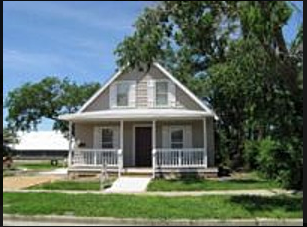 |
| Dick Stinnett - courtesy Bill Stinnett |
I have yet to find Dick in any census records or city directories between his birth and his life in Salina where he first appears in a 1931 directory. He is living at 708 Hancock. The household includes his brother John and sister-in-law Lizzie as well as nephews Tex and George (and his wife Christina).
 |
| 708 Hancock, Salina |
Dick's death certificate says he was widowed (nephew Art Stinnett was informant). I found three marriage records that I believe to be associated with Dick. The first is dated September 19, 1896. The bride's name is difficult to read. She is indexed as Hettie McCormic at FamilySearch but when I look at the document her first name could be Hettie or Nettie and her last name looks more like McCurrin to me. I'm biased toward McCurrin because I know of other family ties to McCurrin/McCurran/McCurn families in that area. Regardless of her name I haven't found any other record of her with the various permutations. Dick and Abe Roland, who secured the marriage bond, were both from Yellville. Dick's 16-year-old bride (he was 26) was from Mountain Home in Baxter County.
 |
| 1896 Marriage record |
A Salina Journal article about Dick's 91st birthday led me to the Crawford County Genealogial Library in Pittsburg, Kansas when I was at Homecoming in Parsons in 2011. The article said Dick had worked as a miner in Pittsburg before moving to Salina 25 years earlier. I had also seen two birth records at FamilySearch that listed Richard/Dick Stinett and Ethel Jackson as the parents of a daughter born Jun 10, 1906 in Pittsburg and a son born July 8, 1907 in Radley (also in Crawford County).
The librarian was very helpful. She not only located the record of Dick's marriage to Ethel Jackson on December 16, 1905, she also found another marriage to a Mrs. Elizabeth McInally on January 1, 1913. Further searching turned up Dick and Ethel's divorce file dated September 19, 1908. Ethel asked for and was awarded custody of their son, Forest; the daughter was not mentioned in the suit. The Crawford County Register of Births list Dick's occupation as miner on both birth records. His nationality on the daughter's record says he is Mexican, born in Mexico City; the son's record lists him as an American born in Arkansas. I am still looking for further information on Dick's wives and children. They are as elusive as he.
Dick died at the Soldan Rest Home in Salina on October 24, 1957. He is buried in Gypsum Hill Cemetery.
UPDATE MARCH 5, 2017
After the divorce, Ethel Maude [Jackson] Stinnett married Charles E. Montee May 28, 1909 in Columbus, Kansas. He was 20 years older than her. Ethel's 2-year-old son is later recorded as Foster Montee rather than Forest Stinnett. I wonder if there was a transcription error of his first name in the divorce hearing proceedings. I just have a hunch this is Dick's son who has taken the Montee surname. Sadly Foster died October 7 1909 of croup and is buried in West Union Cemetery, Chicopee, Kansas. Ethel and Charles had children of their own. She lived in Crawford County until she died in 1960.


















